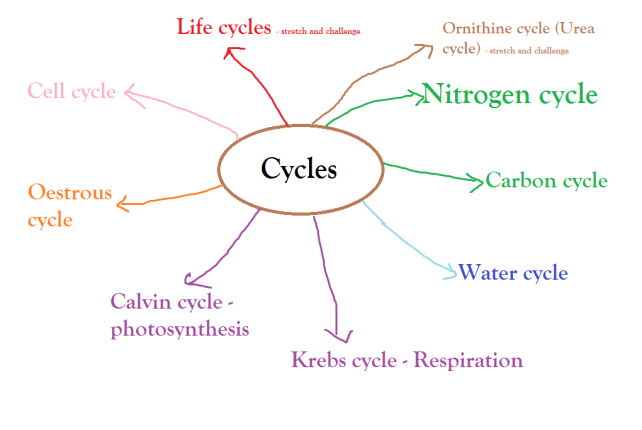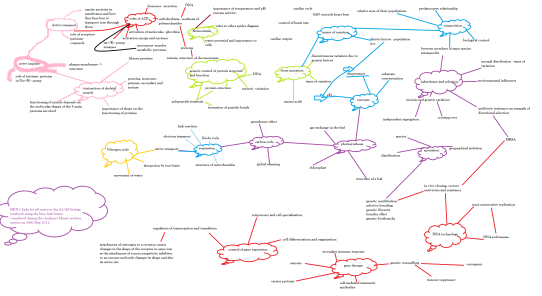Remember that you have a choice of two essays, make your choice carefully. Spend a short period of time jotting down what you know about a topic and choose the one that you can write the most about using sound biological knowledge. Be careful with spelling, especially for terms which look similar but mean different things e.g. glucagon, glycogen and glycerol. In this post I will advise upon:
How to write the essay.
After you have brainstormed and formed a spider diagram, organise your ideas into a logical sequence by numbering them in the order that you will tackle them in the essay. Cross out any ideas that you don’t think you can write a decent amount about using key words and scientific terms and then review your plan to make sure it includes a range of ideas and that they relate to the title of the essay.
Remember to refer back to the plan when you are writing the essay to make sure you are on track and it may help to tick off the points covered as you go along.
Typically the structure of an essay goes like this:
- Introduction
- Paragraph 1
- Paragraph 2
- Paragraph 3
- Paragraph 4
- Paragraph 5
- Conclusion
However, in this essay, there isn’t really any time to write the introduction and the conclusion. Besides you won’t get marks for them. You’ll get marks for the actual content in your essay. However, you can make a quick one sentence introduction for example to define a key word in the title or explain the importance of a general principle.
For example, if the essay was about mutations and its effects on organisms, your first sentence could be a definition of a mutation: A mutation refers to a change in the base sequence of DNA.
If you cannot come up with an introductory sentence, do not bother with it. Go into the essay and write about the first topic that you have numbered in your plan.
Write everything you know about it – that’s the easiest way to get through the essay. Make sure you use scientific terms accurately.
How long should the essay be?
I don’t have a definitive answer to that. How much can you write about the topics in your plan in the space of 45 minutes? As long as you have covered the points in your plan in great depth displaying your knowledge, that’s what matters. Generally, cover about 5 main points in your essay, so at an estimate write 150 words (a long paragraph) about each main point. If we stick with the 5 main points guide, then the essay would be 150 x 5 = 750 words in length- for me this is two and a half pages of A4, for other people that will be different. I think we need to be sensible in length, because aside from the essay we need to leave enough time for the other 75 marks available in the paper.
Practice
To help you make connections between the major themes and topics I have broken down Unit 1 BIOL1 into the main facts and principles.
Unit 1 BIOL1 Biology and Disease
The digestive and gas exchange systems are examples of systems in which humans and other mammals exchange substances with their environment.
Knowledge (facts)
- Digestive system
- Proteins
- Enzyme action
- Gas exchange system
Principles
- exchange of substances with the environment – adaptations
Substances are transported from one part of the body to another by the blood system. An appreciation of the physiology of these systems requires candidates to understand basic principles including the role of enzymes as biological catalysts, and passive and active transport of substances across biological membranes.
Knowledge (facts)
- Circulatory system
- Role of enzymes of biological catalysts
Principles
- Transport
- Diffusion
- Osmosis
- Active Transport
The systems described in this unit, as well as others in the body, may be affected by disease. Some of these diseases, such as cholera and tuberculosis, may be caused by microorganisms. Other noncommunicable diseases such as many of those affecting heart and lung function also have a significant impact on human health. The blood has a number of defensive functions which, together with drugs such as antibiotics, help to limit the spread and effects of disease.
Knowledge (facts)
- Cholera
- Tuberculosis
- Pathogens
- Antibiotics
- Heart function
- Lung function
Principles or concepts
- Defence mechanisms – Immunology
- Causes of disease
Having read through these points, are you starting to see where links can be made with other topics in the A level course?
Example
If we were to take the essay title of the causes of disease, the topics we would include are: “Disease may be caused by infectious pathogens or may reflect the effects of lifestyle.” Then to brainstorm further we would think about what types of organisms are pathogens, “pathogens include bacteria, viruses and fungi“ and also what lifestyle factors increase our risk of disease e.g. smoking and alcohol.
Of course, then we want to bring in knowledge from elsewhere and we could include: mutations (unit 2 and 5) –> cancer (unit 2)/ (unit 5) tetanus – condition to do with the nervous system – there are different types of mutations, and each has a different consequence, in unit 5 we learnt about cystic fibrosis, a consequence of a deletion mutation; other causes of disease: malnutrition –> kwashiorkor (outside of course). This title is an example of when we do not need to include information from every single unit (i.e. unit 4), since unit 4 doesn’t contain relevant information about disease, although thinking about it now we could include information about mitochondrial diseases, if you knew enough about them.
By now, your plan will have many ideas, you only need to pick out a handful that you can talk about well e.g. a bacterial disease, a viral disease, a fungal disease, a lifestyle disease, a disease due to mutations.
~*~
Also I want to highlight the section at the end of Unit 1 in the specification where it says biological principles, and the sections at the end of all the other units too where it says biological principles. For unit 1, it states:
Candidates will be expected to have an understanding of the following principles.
- Proteins and polysaccharides are made up of monomers that are linked by condensation.
- Many of the functions of proteins may be explained in terms of molecular structure and shape.
- Enzymes are proteins and their rates of reaction are influenced by a range of factors: temperature, the presence of inhibitors, pH and substrate concentration.
- Substances are exchanged by passive or active transport across exchange surfaces. The structure of plasma membranes enables control of the passage of substances across exchange surfaces.
This understanding may…be required in the A2 Units where it may contribute to the assessment of synoptic skills.
As you can see from the principles, there is a lot of potential for examiners to draw titles for Biol5 essays from them. Therefore, make sure you know the principles, and it wouldn’t be a bad idea to brainstorm the principles. Possible essay titles from those principles could be:
- Describe the importance of molecular structure and shape.
- Describe and explain the role of proteins and enzymes in organisms.
- Describe the importance of transport systems and explain the adaptations of transport structures.
And another tip: the AQA textbooks have blue link boxes relating topics to other topics elsewhere in the course, I would recommend that you go through these and organise these links into large topic headings.
Example on the page about gene therapy: cystic fibrosis, the blue box refers to AS topics about osmosis and carrier proteins.
~*~
We’ve finally reached the end of the how to tackle the BIOL5 essay series. I hope this has been hopeful to you. If you have any questions, feel free to leave a comment below or send me a message. Essay plans and title suggestions are welcome too. Good luck!









